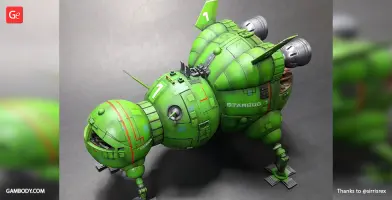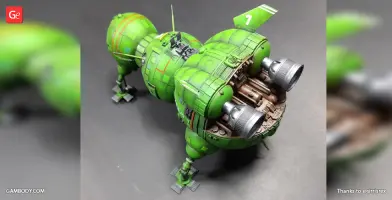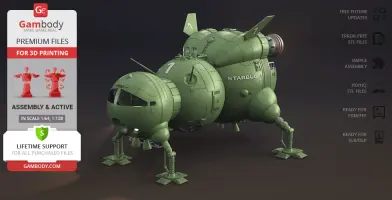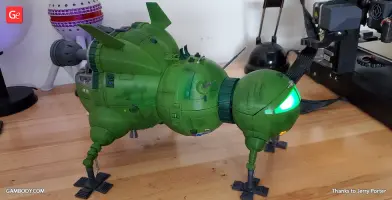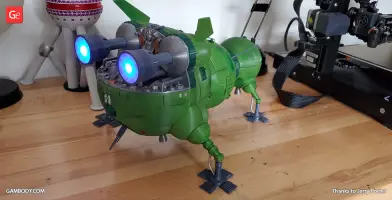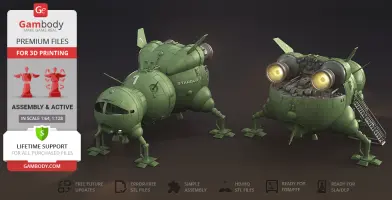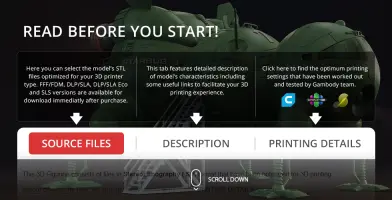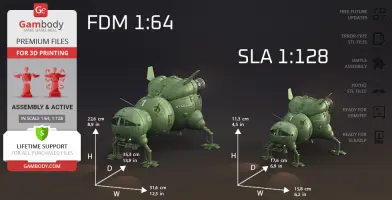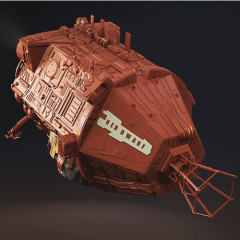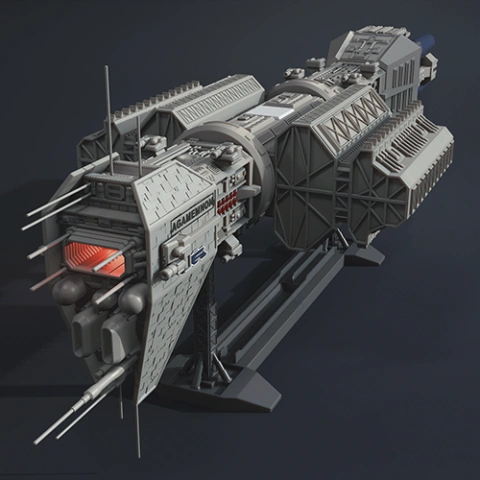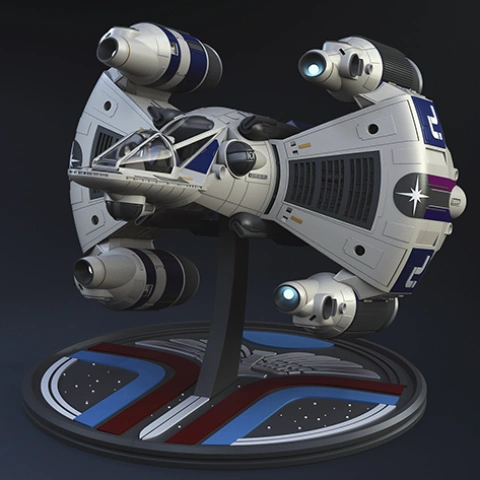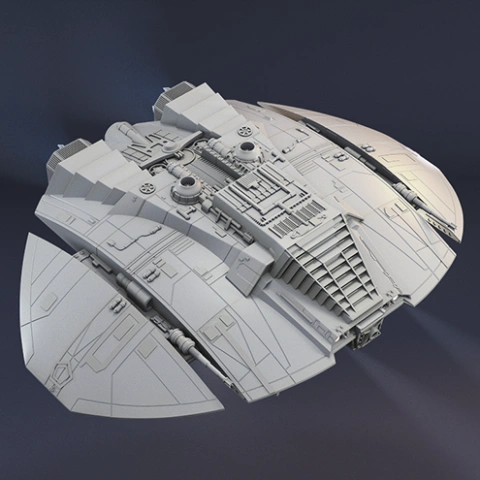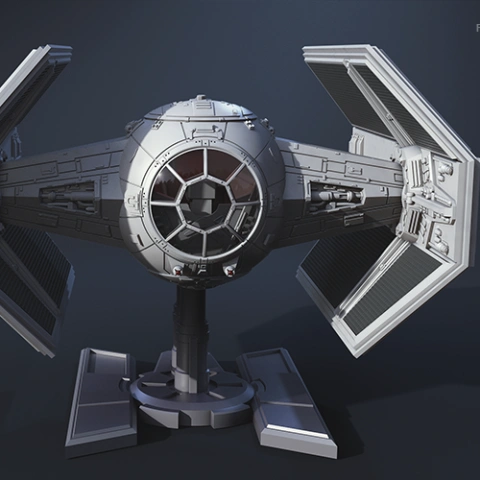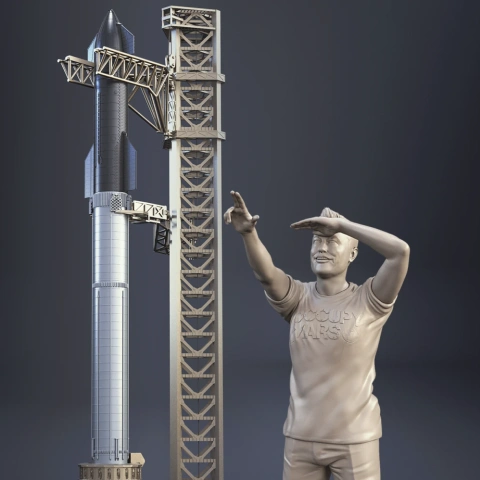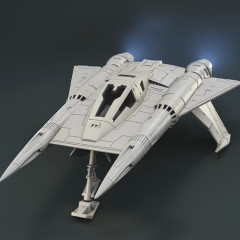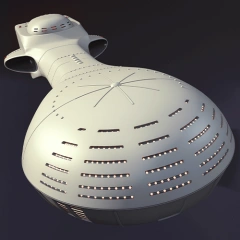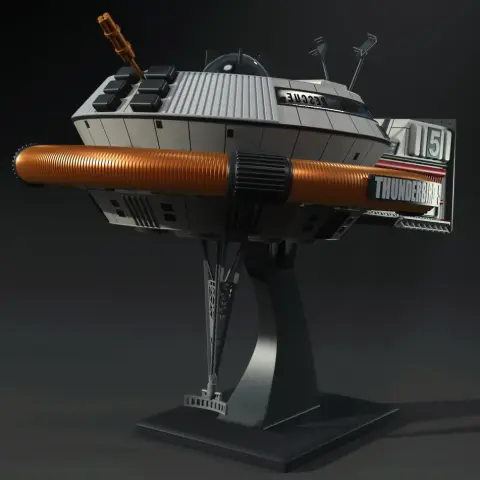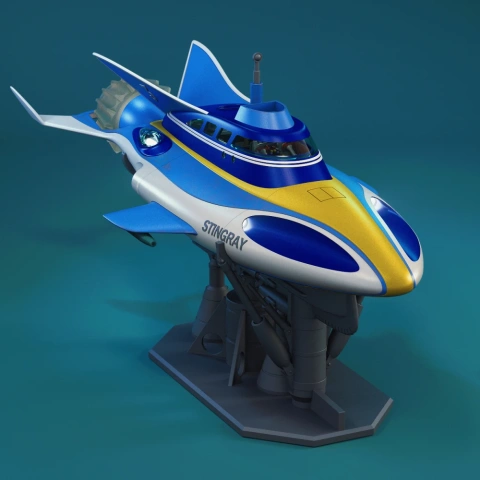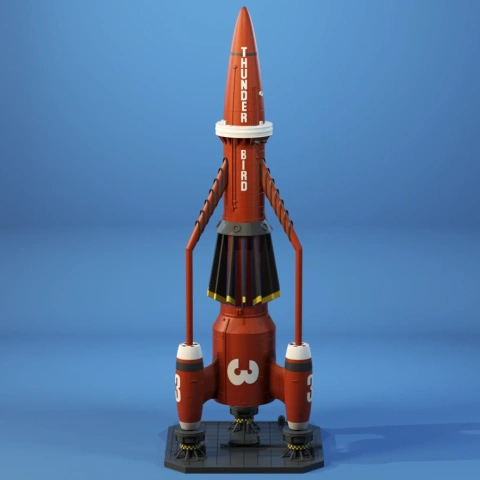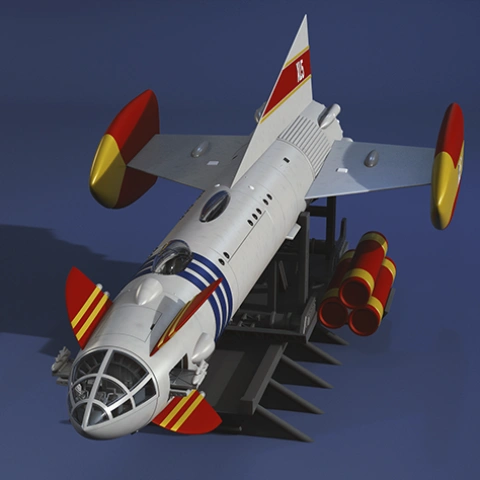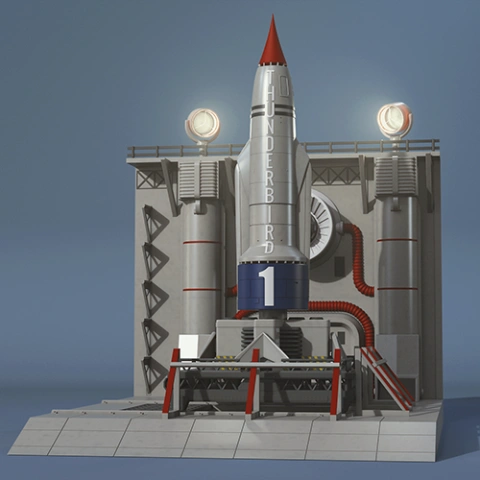Files
3D model format
Stereolithography (.stl)
Total files
Slicer settings
not available
Mesh error check
not specified
Support
Lifetime support from Gambody team
Update requests
not specified
Model versions
FFF/FDM
Assembly method
not specified
Features
DLP/SLA
Assembly method
not specified
Features
Additional details
Part of diorama
No
Special pack included
No
You will get instant access to the STL files of Starbug 3D Printing Model | Assembly + Active after completing your purchase. Simply add the model to your cart and check out using PayPal, credit or debit card, Apple Pay, Google Pay, Alipay, or other available payment methods.
Watch the assembly video for Starbug 3D Printing Model | Assembly + Active, and explore more tutorials, behind-the-scenes content, 3D printing timelapses, and painting guides on the official Gambody YouTube channel.
This 3D Model of the Starbug shuttle-craft from Red Dwarf TV show consists of files in StereoLithography (.Stl) format that is optimized for 3D printing.
Before printing the files, we strongly recommend reading the PRINTING DETAILS section.
WHAT WILL YOU GET AFTER PURCHASE?
- 2 versions of Starbug 1 STL files for FFF/FDM and DLP/SLA - files for all versions are available for download after the purchase
- STL files of high-poly Starbug Shuttle 3D Model for 3D printing consist of 168 parts
- Sizes:
FFF/FDM: 226 mm tall, 316 mm wide, 353 mm deep
DLP/SLA: 113 mm tall, 158 mm wide, 176 mm deep
- Assembly Manual for FFF/FDM 1.0 and DLP/SLA 1.0 versions in PDF format
- Detailed settings that we provide as a recommendation for Cura, Simplify3D, Slic3r and PrusaSlicer for the best print
- Full technical support from the Gambody Support Team
Detailed information about this 3D printing model is available in the DESCRIPTION section.
Before printing, take a look at Printing Details for recommended settings and tips to achieve better results.
ABOUT THIS 3D MODEL
Entertaining adventures await you aboard the Red Dwarf's Starbug shuttlecraft! The vehicle is notable for its peculiar design and exceptional durability that saved our heroes on numerous occasions. Its body is divided into sections akin to a bug’s bulbous body parts - the head serves as the cockpit, the mid-section provides living space for the crew, and the rear segment keeps the cargo and equipment safe. Maybe you would like to pay a visit?
A 3D printer and high-quality STL files of the Starbug 3D Printing Model are all you need to build a sci-fi legend of your own! Thanks to the meticulous effort of our contributing 3D artist, the model boasts incredible interior detail that you can observe through the opening hull. Moreover, the craft is supported by two pairs of active legs that can be posed. Embark on exciting expeditions and see what secrets are hidden in the distant future!
ADAPTATION FOR 3D PRINTING
Starbug for 3D printing is an active assembly model and its moderation and adaptation for different types of 3D printers took the Gambody team 43 hours in total.
For you to receive the cleanest 3D printing result possible and minimize the amount of filament needed for generated support, the craft was divided into convenient assembly parts.
All assembly parts in the FFF/FDM 1.0 version are provided in STL files in recommended positions that were worked out in order to ensure the smoothness of the details’ surfaces after printing and that the 3D printing beginners won't face difficulties when placing the parts on a build plate. When downloading any model's file you will also receive "Assembly Manual" for FFF/FDM 1.0 and DLP/SLA 1.0 versions in PDF format. We highly recommend that you get acquainted with the “Assembly video” and "Assembly Manual" before getting down to the Starbug model.
The model is saved in STL files, a format supported by most 3D printers. All STL files for 3D printing have been checked in Netfabb and no errors were shown.
The model’s scale was calculated from the approximate length of the Starbug which is 22000 mm. The 3D printing model’s chosen scales are 1:64 for the FFF/FDM version and 1:128 for the DLP/SLA versions.
VERSIONS' SPECIFICATIONS
FFF/FDM 1.0 version features:
- Contains 89 parts;
- A printed model is 226 mm tall, 316 mm wide, 353 mm deep;
- Two cockpit window designs - simple window and combined with the reflective cover;
- Two hull cutting options - solidhull and openinghull to display the interior;
- Two hull design options - with and without the raised markings;
- Opening mid-section airlock;
- Highly detailed cockpit;
- Removable doors between the cockpit and mid-section;
- Highly detailed mid-section interior;
- Active joint system in the legs;
- You can display the Starbug with the airstair;
- Two thruster designs for different LED lighting options;
- You can introduce LED wiring to the front lights, cockpit, mid-section, and thrusters; the battery can be stored in the rear section;
- All parts are divided in such a way that you will print them with the smallest number of support structures.
DLP/SLA 1.0 version features:
- Contains 79 parts;
- A printed model is 113 mm tall, 158 mm wide, 176 mm deep;
- Two cockpit window designs - simple window and combined with the reflective cover;
- Two hull cutting options - solidhull and openinghull to display the interior;
- Two hull design options - with and without the raised markings;
- Opening mid-section airlock;
- Highly detailed cockpit;
- Removable doors between the cockpit and mid-section;
- Highly detailed mid-section interior;
- You can display the Starbug with the airstair;
- Two thruster designs for different LED lighting options;
- You can introduce LED wiring to the front lights, cockpit, mid-section, and thrusters; the battery can be stored in the rear section;
- All parts are divided in such a way to fit the build plates and to ensure that support structures are generated where needed.
You can get the model of Starbug for 3D Printing immediately after the purchase! Just click the green Buy button in the top-right corner of the model’s page. You can pay with PayPal or your credit card.
Watch the tutorial on how to assemble Starbug 3D Printing Model on Gambody YouTube channel.
Also, you may like the Red Dwarf Mining Ship 3D Printing Model and other Space Shipsmodels for 3D printing.
_______
FAQ:
Where can I print a model if I have no printer?
How to get started with 3D printing?
How to set up my 3D printer?
How to choose right 3D model print bed positioning?
How to paint printed figurine?
Average customer rating (12 reviews)
4
Ratings breakdown
Click a star rating to filter reviews
Overall experience
Level of detail in the model
4
Model cut quality and assembly guide
4
Clarity and accuracy of the model page
4
Level of detail in the model
5
Model cut quality and assembly guide
5
Clarity and accuracy of the model page
5
Level of detail in the model
5
Model cut quality and assembly guide
5
Clarity and accuracy of the model page
5
Level of detail in the model
4
Model cut quality and assembly guide
4
Clarity and accuracy of the model page
4
Level of detail in the model
2
Model cut quality and assembly guide
2
Clarity and accuracy of the model page
2
Level of detail in the model
4
Model cut quality and assembly guide
4
Clarity and accuracy of the model page
4
Level of detail in the model
5
Model cut quality and assembly guide
5
Clarity and accuracy of the model page
5
Level of detail in the model
3
Model cut quality and assembly guide
3
Clarity and accuracy of the model page
3
Level of detail in the model
4
Model cut quality and assembly guide
4
Clarity and accuracy of the model page
4
Level of detail in the model
5
Model cut quality and assembly guide
5
Clarity and accuracy of the model page
5
Level of detail in the model
1
Model cut quality and assembly guide
1
Clarity and accuracy of the model page
1
Level of detail in the model
5
Model cut quality and assembly guide
5
Clarity and accuracy of the model page
5
Level of detail in the model
5
Model cut quality and assembly guide
5
Clarity and accuracy of the model page
5
To avoid printing issues and achieve the best quality, we highly recommend applying the following settings:
Generic
Generic
Below you can find printing recommendations for Bambu Studio, Cura, Orca Slicer, PrusaSlicer, Simplify3D, and Slic3r software.
Disclaimer: The following printing settings are a recommendation, not an obligation. The parameters can vary depending on the peculiarities of your 3D printer, the material you use, and especially the particular assembly part you are working with. Each part that any model comprises often needs preliminary review, and you are free to tweak the settings the way you find suitable.
Note:
You can scale up the model (downscaling for FFF/FDM 3D printers is not recommended!);
All connectors should be printed at 100% Infill.
Bambu Lab printing recommendations:
These basic 3D printing settings recommendations for beginners were tested in Bambu Studio 1.9.1. Test models were printed on the Bambu Lab A1, Bambu Lab A1 Mini, Creality Ender 3 S1, Anycubic Kobra 2, and Anycubic Vyper using PLA and PETG filaments.
To avoid printing problems, we recommend the following settings: download
Cura printing recommendations:
These are averaged settings which were tested in the Cura 5.2.1 slicer. Test models were printed on Anycubic Vyper, Creality Ender 3 Pro with PLA filament.
To avoid printing problems, we recommend the following settings: download
Orca Slicer printing recommendations:
These basic 3D printing settings recommendations for beginners were tested in Orca Slicer 2.3.0. Test models were printed on Bambu Lab A1, Bambu Lab A1 Mini, Creality Ender 3 V3, and Anycubic Kobra 3 with PLA and PETG filament.
To avoid printing problems, we recommend the following settings: download
PrusaSlicer printing recommendations:
These basic 3D printing settings recommendations for beginners were tested in PrusaSlicer 2.3.1. Test models were printed on Ultimaker 2, Creality Ender 3, Creality Cr-10S pro v2, Anycubic I3 Mega, Anycubic I3 MegaS, Anycubic Vyper with PLA and PETG filaments.
To avoid printing problems, we recommend the following settings: download
Simplify3D printing recommendations:
These are averaged settings which were tested in the Simplify3D 5.0.0 slicer. Test models were printed on Anycubic Vyper, FLSUN v400, Ender3 S1 with PLA filament.
To avoid printing problems, we recommend the following settings: download
Slic3r printing recommendations:
These basic 3D printing settings recommendations for beginners were tested in Slic3r 1.3.0 software. Test models were printed on Ultimaker 2, Creality Ender 3, Creality Cr-10S pro v2, Anycubic I3 Mega, Anycubic I3 MegaS, Anycubic Vyper with PLA and PetG filaments.
To avoid printing problems, we recommend the following settings: download
